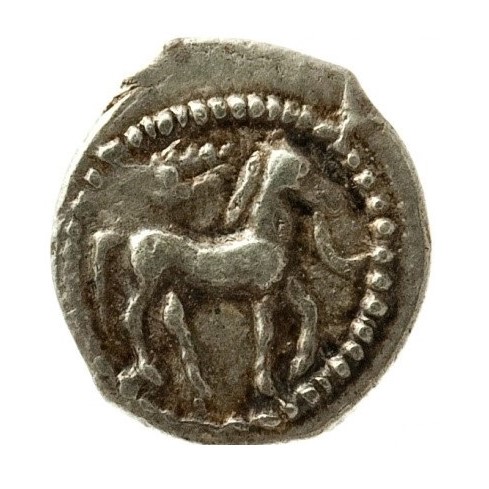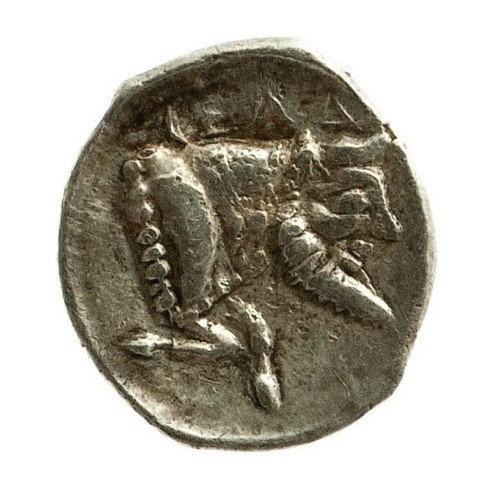Title: Litra of Gela (Sicily) - 1990.01
Acquisition number: 1990.01
Author or editor: Douglas Kelly
Culture or period: Classical Greece.
Date: c. 465 - 450 BC.
Material: Metal - Silver
Object type: Coins - Greek
Dimensions: 21mm (w)
Origin region or location: Italy
Origin city: Gela.
Display case or on loan: 5
Keywords: Coin, Greek, litra, Gela, Sicily, Gelas, Syrakousai, Syracuse
G.K. Jenkins, The coinage of Gela (Berlin, 1970).
Sylloge Nummorum Graecorum, USA, The Collection of the American Numismatic Society (New York, The American Numismatic Society, 1969-), 54-60.
Sylloge Nummorum Graecorum, Copenhagen, The Royal Collection of Coins and Medals, Danish National Museum, repr. edn (West Milford, NJ, 1981-), 272.
D.R. Sear, Greek Coins and their Values, vol. 1, Europe (London, Seaby, 1978), 791.
1990.01
Litra of Gela (Sicily)
Silver, 0.72 g. 21 mm. c. 465-450 BC.
Obv.: Horse facing r. with bridle in its mouth; above, wreath.
Rev.: Forepart of man-headed bull r., with beard.
The coinage of Gela revived in c. 465 BC after the death of Hieron, tyrant of Syrakousai (Syracuse), when the population of Gela, which the tyrant’s brother and predecessor Gelon had moved to Syrakousai, returned to their own city.
By this time Gela, like other Greek cities in Sicily, was using a silver tetradrachmon of c. 17.20 g. Another weight standard was also in use, that of the litra (adopted from the native Sicel population), in which a litra of silver weighed c. 0.76 g. Five silver litrae were equal to one silver drachma.
The reverse image is of the river-god Gelas, deity of the river of that name, on the mouth of which stood the city of Gela. The bull, the largest animal familiar to Greeks, was a common symbol of irresistible physical power, like that of a strongly-flowing river.
G.K. Jenkins, The coinage of Gela (Berlin, 1970).
Sylloge Nummorum Graecorum, USA, The Collection of the American Numismatic Society (New York, The American Numismatic Society, 1969-), 54-60.
Sylloge Nummorum Graecorum, Copenhagen, The Royal Collection of Coins and Medals, Danish National Museum, repr. edn (West Milford, NJ, 1981-), 272.
D.R. Sear, Greek Coins and their Values, vol. 1, Europe (London, Seaby, 1978), 791.

